Beyond Illumination: Stakeholder Perspectives on Urban Lighting Master Planning for Chiang Mai Old City, Thailand
Abstract
1. Introduction
2. Literature Review
2.1. The Paradigm Shift in Urban Lighting Master Planning
2.2. Factors in Urban Lighting Master Plan Development
2.2.1. Safety and Security
2.2.2. Social
2.2.3. Economy
2.2.4. Cultural and Heritage
2.2.5. Well-Being
2.2.6. Environment
2.2.7. Technology
2.2.8. Regulation
2.3. Stakeholders in Urban Lighting Master Planning
2.4. Participation in Urban Master Planning
2.4.1. Urban Design and Planning Participation
2.4.2. Participation in Urban Lighting Design
2.5. Visualisation Tool for Urban Complexity
3. Materials and Methods
3.1. Site and Setting: Chiang Mai Old City
3.2. Research Design
3.2.1. Stage 1: Literature Review
3.2.2. Stage 2: Research Framing
3.2.3. Stage 3: Data Collection—Semi-Structured In-Depth Interviews and Focus Groups
3.2.4. Stage 4: Data Analysis—Identifying the Critical Factors and Key Stakeholders
3.2.5. Stage 5: CLDs Visualization Modeling
3.3. Data Collection: Semi-Structured, In-Depth Interviews, and Focus Groups
3.4. Research Participants
3.4.1. Participant Selection
- Government sector: Participants must hold positions within local or national government agencies or regulatory bodies involved in urban planning, public safety, or environmental regulations.
- Professional sector: Participants should be professionals with expertise in urban lighting design, including architects, lighting designers, engineers, supplier, and consultants.
- End user: Participants must represent private sector entities such as business owners, property developers, civil society, or community organizations that are directly impacted by urban lighting.
3.4.2. Participant Recruitment
3.5. Sample Size
3.6. Data Analysis Process
3.7. Visualization and Implication
4. Results
4.1. In-Depth Interviews and Focus Group Outcomes
4.1.1. Satisfaction with Existing Urban Lighting
4.1.2. Perspective and Vision
4.1.3. Top Three Critical Factors
4.1.4. Strengths and Potential of Chiang Mai Old City
4.1.5. Suggestions for Urban Lighting Development for Chiang Mai Old City
4.2. CM and CLD Visualizataion
4.2.1. Identifying the System Boundaries and Scopes
4.2.2. Identifying Feedback Loops and Thematical Clusters
4.2.3. Proposing Thematic Clusters, Possible Initial Scenarios
4.2.4. Developing Phasing Plan
5. Discussion and Conclusions
5.1. Evaluating Critical Factors
5.1.1. Primary Concern Factor: Safety and Security
5.1.2. Uniqueness Factor: Cultural and Heritage
5.1.3. Driver Factor: Economy
5.1.4. Sensitive Factor: Well-Being and Environment
5.1.5. Problem-Solving Factor: Technology and Regulation
5.1.6. Tricker Factors: Social
5.1.7. Unexpected Factor: Mechanisms, Technical, Administration, and People Factors in Urban Lighting Master Plan Success
5.1.8. Shared-Interest Factor Between Local and Non-Local Participants: Cultural and Heritage
5.2. Relationship Among Urban Lighting Design Factors
5.3. Implementation
5.3.1. Urban Lighting Design Considerations for Cultural Heritage Cities
5.3.2. The Application of Maslow’s Hierarchy of Needs in Urban Lighting at City Scale
5.3.3. Application of the System Dynamic Approach
5.3.4. Application of Multi-Stage Approach in Urban Lighting Master Planning
5.3.5. Participatory Process: Challenges and Further Exploration
6. Conclusions and Suggestions
- Conducting Comprehensive Stakeholder Analysis: Conduct a thorough stakeholder analysis to ensure more realistic and applicable urban lighting scenarios. Different stakeholder groups, each responsible for specific roles and stages in the planning process [28,32,33] have distinct short-term and long-term expectations, with different beneficiaries receiving value at each stage [31]
- Validation and Refinement of CLDs with Stakeholders: Engage in additional focus group discussions with diverse stakeholders to validate and refine the CLDs. This will ensure that the identified loops accurately reflect stakeholders’ realities, concerns, and priorities, bridging the gap between theoretical models and practical application. This process will also help reduce researcher bias, making the urban lighting strategy more grounded and inclusive.
- Development of CLDs into System Dynamics Models: Expand the CLDs into comprehensive SD models to provide a dynamic, quantitative analysis of urban system. SD modeling can simulate interactions and changes over time, offering insights into long-term impacts of urban lighting decisions. These insights should inform hypotheses that guide the testing of various urban lighting scenarios, leading to a more holistic and adaptive urban lighting master plan.
- Conducting Comparative Studies Across Cultural Contexts: Conduct comparative studies across diverse cultural, geographical, and demographic contexts to assess the applicability and scalability of this framework in other heritage cities.
- Sensitive Demographic Groups Investigation: Explore the contrasting needs of tourists and residents to identify leverage points that balance their interests.
- Well-Being and Environmental Impact Examination: Investigate the effects of urban lighting development on animal and wildlife well-being to ensure that lighting proposals promote sustainability.
- Innovative Lighting Solutions Exploration towards sustainable development: Utilize participatory insights to investigate lighting dynamics and technological innovations in urban lighting standards and design guidelines. Solutions like smart lighting systems should balance human, environmental, cultural, and aesthetic needs that contribute to sustainable urban lighting systems.
Author Contributions
Funding
Institutional Review Board Statement
Informed Consent Statement
Data Availability Statement
Acknowledgments
Conflicts of Interest
References
- Roberts, M.; Eldridge, A. Quieter, Safer, Cheaper: Planning for a More Inclusive Evening and Night-Time Economy. Plan. Pract. Res. 2007, 22, 253–266. [Google Scholar] [CrossRef]
- Bromley, R.; Thomas, C.; Millie, A. Exploring Safety Concerns in the Night-Time City: Revitalising the Evening Economy. Town Plan. Rev. 2000, 71, 71. [Google Scholar] [CrossRef]
- Bromley, R.D.F.; Tallon, A.R.; Thomas, C.J. Disaggregating the Space–Time Layers of City-Centre Activities and Their Users. Environ. Plan. Econ. Space 2003, 35, 1831–1851. [Google Scholar] [CrossRef]
- Roberts, M. Planning, Urban Design and the Night-Time City: Still at the Margins? Criminol. Crim. Justice 2009, 9, 487–506. [Google Scholar] [CrossRef]
- Eldridge, A.; Smith, A. Tourism and the Night: Towards a Broader Understanding of Nocturnal City Destinations. J. Policy Res. Tour. Leis. Events 2019, 11, 371–379. [Google Scholar] [CrossRef]
- Lin, V.S.; Qin, Y.; Ying, T.; Shen, S.; Lyu, G. Night-Time Economy Vitality Index: Framework and Evidence. Tour. Econ. 2022, 28, 665–691. [Google Scholar] [CrossRef]
- Xiong, S.; Wang, H.; Liao, Z.; Hashim, R. Exploring the Factors and Spatial Patterns of National Night Cultural Tourism Consumption Agglomeration Zones in China. Heliyon 2024, 10, e24132. [Google Scholar] [CrossRef]
- ARUP. Cities Alive: Rethinking the Shades of Night. Available online: https://www.arup.com/insights/cities-alive-rethinking-the-shades-of-night/ (accessed on 25 September 2024).
- Huang, W.-J.; Wang, P. “All That’s Best of Dark and Bright”: Day and Night Perceptions of Hong Kong Cityscape. Tour. Manag. 2018, 66, 274–286. [Google Scholar] [CrossRef]
- Chen, N.; Wang, Y.; Li, J.; Wei, Y.; Yuan, Q. Examining Structural Relationships among Night Tourism Experience, Lovemarks, Brand Satisfaction, and Brand Loyalty on “Cultural Heritage Night” in South Korea. Sustainability 2020, 12, 6723. [Google Scholar] [CrossRef]
- de Frutos, L.; Pellizzari, L.; Hvass, M. The Influence of Urban Lighting on the Sense of Belonging. IOP Conf. Ser. Earth Environ. Sci. 2024, 1320, 012011. [Google Scholar] [CrossRef]
- Turekulova, A.I.; Kovatchev, A.D.; Iskhojanova, G.R. Methodological Approach to Creating an Urban Lighting Atmosphere with Regard to Human Needs. Spatium 2020, 2020, 16–25. [Google Scholar] [CrossRef]
- Boyce, P.R. The Benefits of Light at Night. Build. Environ. 2019, 151, 356–367. [Google Scholar] [CrossRef]
- Del-Negro The Effects of Artificial Lighting on Urban Legibility and Wayfinding. Ph.D. Thesis, UCL (University College London), London, UK, 2016.
- Böhme, G. Light and Space. On the Phenomenology of Light. Dialogue Univers. 2014, 24, 62–73. [Google Scholar] [CrossRef]
- Johansson, M.; Rosén, M.; Küller, R. Individual Factors Influencing the Assessment of the Outdoor Lighting of an Urban Footpath. Light. Res. Technol. 2011, 43, 31–43. [Google Scholar] [CrossRef]
- Zielinska-Dabkowska, K.M.; Bobkowska, K. Rethinking Sustainable Cities at Night: Paradigm Shifts in Urban Design and City Lighting. Sustainability 2022, 14, 6062. [Google Scholar] [CrossRef]
- Portnov, B.A.; Saad, R.; Trop, T.; Kliger, D.; Svechkina, A. Linking Nighttime Outdoor Lighting Attributes to Pedestrians’ Feeling of Safety: An Interactive Survey Approach. PLoS ONE 2020, 15, e0242172. [Google Scholar] [CrossRef]
- Himschoot, E.A.; Crump, M.C.; Buckley, S.; Cai, C.; Lawson, S.; White, J.; Beeco, A.; Taff, B.D.; Newman, P. Feelings of Safety for Visitors Recreating Outdoors at Night in Different Artificial Lighting Conditions. J. Environ. Psychol. 2024, 97, 102374. [Google Scholar] [CrossRef]
- Entwistle, J.; Slater, D. Making Space for ‘the Social’: Connecting Sociology and Professional Practices in Urban Lighting Design. Br. J. Sociol. 2019, 70, 2020–2041. [Google Scholar] [CrossRef]
- Bille, M. Review: Gernot Böhme, 2017, The Aesthetics of Atmospheres; Thibaud, J.-P., Ed.; Routledge: London, UK, 2018. [Google Scholar]
- Edensor, T.; Millington, S. Illuminations, Class Identities and the Contested Landscapes of Christmas. Sociology 2009, 43, 103–121. [Google Scholar] [CrossRef]
- Giordano, E. Outdoor Lighting Design as a Tool for Tourist Development: The Case of Valladolid. Eur. Plan. Stud. 2018, 26, 55–74. [Google Scholar] [CrossRef]
- Schulte-Römer, N.; Dannemenn, E.; Meier, J. Light Pollution-A Global Discussion; Helmholtz Centre for Environmental Research—UFZ: Leipzig, Germany, 2018; ISBN 978-3-944280-03-5. [Google Scholar]
- ARUP. Lighting in the Urban Age Meaningful Design for Cities, People & Places. Available online: https://docslib.org/doc/11555420/lighting-in-the-urban-age-meaningful-design-for-cities-people-places (accessed on 26 September 2024).
- Zielinska-Dabkowska, K.M. Chapter 2: Urban Lighting Masterplan—Origins, Definitions, Methodologies and Collaborations. In Urban Lighting for People: Evidence-Based Lighting Design for the Built Environment; Davoudian, N., Ed.; RIBA Publishing: London, UK, 2019; pp. 18–41. ISBN 978-1-85946-821-0. [Google Scholar]
- LUCI Association Exploring. City Nightscapes; LUCI Association: Lyon, France, 2020; ISBN 978-2-9538202-3-6. [Google Scholar]
- Pluchinotta, I.; Salvia, G.; Zimmermann, N. The Importance of Eliciting Stakeholders’ System Boundary Perceptions for Problem Structuring and Decision-Making. Eur. J. Oper. Res. 2022, 302, 280–293. [Google Scholar] [CrossRef] [PubMed]
- Adhi, A.B.; Muslim, F. Development of Stakeholder Engagement Strategies to Improve Sustainable Construction Implementation Based on Lean Construction Principles in Indonesia. Sustainability 2023, 15, 6053. [Google Scholar] [CrossRef]
- Prebanić, K.R.; Vukomanović, M. Exploring Stakeholder Engagement Process as the Success Factor for Infrastructure Projects. Buildings 2023, 13, 1785. [Google Scholar] [CrossRef]
- Carmona, M.; De Magalhães, C.; Edwards, M. Stakeholder Views on Value and Urban Design. J. Urban Des. 2002, 7, 145–169. [Google Scholar] [CrossRef]
- Spadaro, I.; Pirlone, F.; Bruno, F.; Saba, G.; Poggio, B.; Bruzzone, S. Stakeholder Participation in Planning of a Sustainable and Competitive Tourism Destination: The Genoa Integrated Action Plan. Sustainability 2023, 15, 5005. [Google Scholar] [CrossRef]
- Zingraff-Hamed, A.; Hüesker, F.; Lupp, G.; Begg, C.; Huang, J.; Oen, A.; Vojinovic, Z.; Kuhlicke, C.; Pauleit, S. Stakeholder Mapping to Co-Create Nature-Based Solutions: Who Is on Board? Sustainability 2020, 12, 8625. [Google Scholar] [CrossRef]
- Pluchinotta, I.; Pagano, A.; Vilcan, T.; Ahilan, S.; Kapetas, L.; Maskrey, S.; Krivtsov, V.; Thorne, C.; O’Donnell, E. A Participatory System Dynamics Model to Investigate Sustainable Urban Water Management in Ebbsfleet Garden City. Sustain. Cities Soc. 2021, 67, 102709. [Google Scholar] [CrossRef]
- Geekiyanage, D.; Fernando, T.; Keraminiyage, K. Mapping Participatory Methods in the Urban Development Process: A Systematic Review and Case-Based Evidence Analysis. Sustainability 2021, 13, 8992. [Google Scholar] [CrossRef]
- Tomoaia-Cotisel, A.; Hyunjung, K.; Allen, S.; Blanchet, K. Causal Loop Diagrams: A Tool for Visualizing Emergent System Behaviour. In Applied Systems Thinking for Health Systems Research: A Methodological Handbook; McGraw Hill: London, UK, 2017; pp. 97–114. [Google Scholar]
- Coletta, V.R.; Pagano, A.; Pluchinotta, I.; Zimmermann, N.; Davies, M.; Butler, A.; Fratino, U.; Giordano, R. Participatory Causal Loop Diagrams Building for Supporting Decision-Makers Integrating Flood Risk Management in an Urban Regeneration Process. Earths Future 2024, 12, e2023EF003659. [Google Scholar] [CrossRef]
- Pluchinotta, I.; Zhou, K.; Moore, G.; Salvia, G.; Belesova, K.; Mohajeri, N.; Hale, J.; Davies, M.; Zimmermann, N. Co-Producing Knowledge on the Use of Urban Natural Space: Participatory System Dynamics Modelling to Understand a Complex Urban System. J. Environ. Manag. 2024, 353, 120110. [Google Scholar] [CrossRef]
- Dhirasasna, N.; Sahin, O. A Multi-Methodology Approach to Creating a Causal Loop Diagram. Systems 2019, 7, 42. [Google Scholar] [CrossRef]
- Srinurak, N.; Mishima, N. Study on Urban Morphology and Public Space Location to Identify Character of Historic Town; Case Study of Chiang Mai. In Proceedings of the EAROPH 2015; Eastern Regional Organization for Planning and Human Settlement, Saga, Japan, 1–3 June 2015. [Google Scholar]
- Srinurak, N.; Mishima, N. Urban Axis and City Shape Evaluation through Spatial Configuration in ‘Lan Na’ Northern Thailand Historic City. City Territ. Archit. 2017, 4, 10. [Google Scholar] [CrossRef]
- Phetsuriya, N.; Heath, T. Defining the Distinctiveness of Urban Heritage Identity: Chiang Mai Old City, Thailand. Soc. Sci. 2021, 10, 101. [Google Scholar] [CrossRef]
- Phetsuriya, N.; Heath, T. In the Architects’ Eyes and Local People’s Perception: The Further Management of Streetscape Characteristics in Chiang Mai Old City, Thailand. In Proceedings of the 14th international conference on Thai Studies; Center of Southeast Asian Studies, Kyoto University: Kyoto, Japan, 2022. [Google Scholar]
- Somnuxpong, S. Chiang Mai: A Creative City Using Creative Tourism Management. J. Urban Cult. Res. 2020, 20, 113–132. [Google Scholar] [CrossRef]
- Nathiwutthikun, K.; Peerapun, W.; Paksukcharern, K. The Logic of Multi-Use of Public Open Spaces in Chiang Mai City. Nakhara J. Environ. Des. Plan. 2008, 4, 45–68. [Google Scholar]
- Srisuwan, C. Nam ruāng phatthanākān khōng phut sathāpattayakam nai prathēt Thai. In Phutsathāpattayakam; Srisuwan, C., Ed.; Faculty of Architecture, Chiang Mai University: Chiang Mai, Thailand, 2017; pp. 15–25. ISBN 978-616-398-166-0. [Google Scholar]
- Bista, A.; Bista, D.; Bhattarai, H.; Bhusal, P. Constrains of Lighting Design and Installation in Complex Spaces: A Case Study of Lighting in Nepalese Heritage Sites. In Proceedings of the 2023 IEEE Sustainable Smart Lighting World Conference & Expo (LS18), Mumbai, India, 8–10 June 2023; pp. 1–5. [Google Scholar]
- Sullia Vijayananda, A. Lighting as a Placemaking Tool for a Historic Urban Market Promenade. Master’s Thesis, KTH Royal Institute of Technology, Stockholm, Sweden, 2022. [Google Scholar]
- Zeini Aslani, S.; Mozaffar, R.; Ekhlassi, A.; Taghdir, S.; Mozaffar, H. Placemaking in Historic Sites with Lighting Scheme Case Study: Naghshe-Jahan Square, Isfahan, Iran. Iran Univ. Sci. Technol. 2022, 32, 10–30. [Google Scholar] [CrossRef]
- Bustamante-Calabria, M.; Martín-Ruiz, S.; Sánchez de Miguel, A.; Ortiz, J.L.; Vílchez, J.M.; Aceituno, J. Characterisation of Night-Time Outdoor Lighting in Urban Centres Using Cluster Analysis of Remotely Sensed Light Emissions. Remote Sens. Appl. Soc. Environ. 2024, 34, 101183. [Google Scholar] [CrossRef]
- Calvillo Cortés, A.B.; Falcón Morales, L.E. Emotions and the Urban Lighting Environment: A Cross-Cultural Comparison. Sage Open 2016, 6, 2158244016629708. [Google Scholar] [CrossRef]
- Institution of Lighting Engineers. The Outdoor Lighting Guide; Routledge: London, UK, 2019; ISBN 978-0-203-03008-0. [Google Scholar]
- Illuminating Engineering Society of North America. The IESNA Lighting Handbook: Reference & Application, 9th ed.; Iluminating Engineering Society of North Amercia: New York, NY, USA, 2000; ISBN 978-0-87995-150-4. [Google Scholar]
- Illuminating Engineering Society of North America. The Lighting Handbook: Reference and Application, 10th ed.; Illuminating Engineering Society of North America: New York, NY, USA, 2011; ISBN 978-0-87995-241-9. [Google Scholar]
- British Standards Institution. BS 5489-1:2020 Design of Road Lighting: Lighting of Roads and Public Amenity Areas. Code of Practice; British Standards Institution: London, UK, 2020. [Google Scholar]
- Society of Light and Lighting. The SLL Lighting Handbook; CIBSE: London, UK, 2009; ISBN 978-1-906846-02-2. [Google Scholar]
- CIE Commission Internationale de l’Eclairage. CIE 234: A Guide for Urban Masterplanning; CIE: Vienna, Austria, 2019. [Google Scholar]
- Narboni, R. From Light Urbanism to Nocturnal Urbanism. Light Eng. 2016, 24, 19–24. [Google Scholar]
- Meier, J.; Hasenöhrl, U.; Krause, K.; Pottharst, M. Urban Lighting, Light Pollution and Society; Routledge: New York, NY, USA, 2015; ISBN 978-1-315-74781-1. [Google Scholar]
- Peña-García, A.; Castillo-Martínez, A.; Ernst, S. The Basic Process of Lighting as Key Factor in the Transition towards More Sustainable Urban Environments. Sustainability 2024, 16, 4028. [Google Scholar] [CrossRef]
- Maslow, A.H. Motivation and Personality; Harper: New York, NY, USA, 1954. [Google Scholar]
- Johansson, M.; Pedersen, E.; Maleetipwan-Mattsson, P.; Kuhn, L.; Laike, T. Perceived Outdoor Lighting Quality (POLQ): A Lighting Assessment Tool. J. Environ. Psychol. 2014, 39, 14–21. [Google Scholar] [CrossRef]
- Zielinska-Dabkowska, K.M. Night in a Big City. Light Festivals as a Creative Medium Used at Night and Their Impact on the Authority, Significance and Prestige of a City. In The Role of Cultural Institutions and Events in the Marketing of Cities and Regions; Domański, T., Ed.; Wydawnictwo Uniwersytetu Łódzkiego: Łódź, Poland, 2016; pp. 63–90. ISBN 978-83-8088-149-5. [Google Scholar]
- Edensor, T. Light Design and Atmosphere. Vis. Commun. 2015, 14, 331–350. [Google Scholar] [CrossRef]
- Edensor, T. Light Art, Perception, and Sensation. Senses Soc. 2015, 10, 138–157. [Google Scholar] [CrossRef]
- Edensor, T. The Gloomy City: Rethinking the Relationship between Light and Dark. Urban Stud. 2015, 52, 422–438. [Google Scholar] [CrossRef]
- Zielinska-Dabkowska, K.; Xavia, K. Historic Urban Settings, LED Illumination and Its Impact on Nighttime Perception, Visual Appearance, and Cultural Heritage Identity. In Proceedings of the 5th International Multidisciplinary Scientific Conference on Social Sciences and Arts: SGEM 2018, Florence, Italy, 23–26 October 2018; Volume 5, pp. 277–292. [Google Scholar]
- Veitch, J.A. Lighting for Well-Being: A Revolution in Lighting? In Proceedings of the 2nd CIE Expert Symposium on Lighting and Health, Ottawa, ON, USA, 7 September 2006; pp. 56–61. [Google Scholar]
- Zielinska-Dabkowska, K.M. Make Lighting Healthier. Nature 2018, 553, 274–276. [Google Scholar] [CrossRef]
- Zielinska-Dabkowska, K.M.; Xavia, K. Looking Up to the Stars. A Call for Action to Save New Zealand’s Dark Skies for Future Generations to Come. Sustainability 2021, 13, 13472. [Google Scholar] [CrossRef]
- Pérez Vega, C.; Zielinska-Dabkowska, K.; Hölker, F. Urban Lighting Research Transdisciplinary Framework—A Collaborative Process with Lighting Professionals. Int. J. Environ. Res. Public. Health 2021, 18, 624. [Google Scholar] [CrossRef]
- Hölker, F.; Bolliger, J.; Davies, T.W.; Giavi, S.; Jechow, A.; Kalinkat, G.; Longcore, T.; Spoelstra, K.; Tidau, S.; Visser, M.E.; et al. 11 Pressing Research Questions on How Light Pollution Affects Biodiversity. Front. Ecol. Evol. 2021, 9, 767177. [Google Scholar] [CrossRef]
- Ebbensgaard, C.L. Illuminights: A Sensory Study of Illuminated Urban Environments in Copenhagen. Space Cult. 2015, 18, 112–131. [Google Scholar] [CrossRef]
- Zielińska-Dabkowska, K.M.; Xavia, K.; Bobkowska, K. Assessment of Citizens’ Actions against Light Pollution with Guidelines for Future Initiatives. Sustainability 2020, 12, 4997. [Google Scholar] [CrossRef]
- Cellucci, L.; Burattini, C.; Drakou, D.; Gugliermetti, F.; Bisegna, F.; Vollaro, A.; Salata, F.; Golasi, I. Urban Lighting Project for a Small Town: Comparing Citizens and Authority Benefits. Sustainability 2015, 7, 14230–14244. [Google Scholar] [CrossRef]
- Boyce, P. Editorial: Is There a Science of Lighting Design? Light. Res. Technol. 2019, 51, 329. [Google Scholar] [CrossRef]
- The Canadian National Committee of the Commission Internationale de l’Eclairage. Minutes of the 43rd Annual CNC/CIE Meeting. Available online: https://cms.cnc-cie.ca/images/documents/AnnualReports/CNCCIE43rdAnnualReport1998.pdf (accessed on 26 September 2024).
- Ittai, V. The Importance of Stakeholder Involvement in Urban Design and Planning. Afr. J. Geogr. Reg. Plan. 2023, 10, 1–2. [Google Scholar]
- McGlynn, S.; Murrain, P. The Politics of Urban Design. Plan. Pract. Res. 1994, 9, 311–319. [Google Scholar] [CrossRef]
- Bullivant, L. From Masterplanning to Adaptive Planning: Understanding the Contemporary Tools and Processes for Civic Urban Order. Ph.D. Thesis, London Metropolitan University, London, UK, 2014. [Google Scholar]
- Semeraro, T.; Nicola, Z.; Lara, A.; Sergi Cucinelli, F.; Aretano, R. A Bottom-Up and Top-Down Participatory Approach to Planning and Designing Local Urban Development: Evidence from an Urban University Center. Land 2020, 9, 98. [Google Scholar] [CrossRef]
- Dias, N.; Curwell, S.; Bichard, E. The Current Approach of Urban Design, Its Implications for Sustainable Urban Development. Procedia Econ. Finance 2014, 18, 497–504. [Google Scholar] [CrossRef]
- Wong, Y.L. What Is Participatory Planning in the Urban Setting? SSRN Electron. J. 2023. [Google Scholar] [CrossRef]
- Arnstein, S.R. A Ladder Of Citizen Participation. J. Am. Inst. Plann. 1969, 35, 216–224. [Google Scholar] [CrossRef]
- Collins, K.; Ison, R. Dare We Jump off Arnstein’s Ladder? Social Learning as a New Policy Paradigm. In Proceedings of the PATH (Participatory Approaches in Science & Technology) Conference, Edinburgh, UK, 4–7 June 2006. [Google Scholar]
- Theyyan, B.M. Arnstein’s Ladder of Citizen Participation A Critical Discussion. Asian Acad. Res. J. Multidiscip. 2018, 2, 241–247. [Google Scholar]
- Halton, E. Review of Habermas Theory of Communicative Action. Symb. Interact. 1989, 12, 333–360. [Google Scholar] [CrossRef]
- Freeman, R.E.E.; McVea, J. A Stakeholder Approach to Strategic Management. SSRN Electron. J. 2001. [Google Scholar] [CrossRef]
- Busch-Jensen, P. Community of Practice. In Encyclopedia of Critical Psychology; Teo, T., Ed.; Springer: New York, NY, USA, 2014; pp. 280–284. ISBN 978-1-4614-5583-7. [Google Scholar]
- Innes, J.E.; Booher, D.E. Collaborative Rationality as a Strategy for Working with Wicked Problems. Landscape and Urban Planning 2016, 154, 8–10. [Google Scholar] [CrossRef]
- Pihlajaniemi, H.; Oesterlund, T.; Tanska, T. Tools for Interaction and User Participation in Urban Lighting: Lightstories Case. In Proceedings of the 30th eCAADe Conference, Prague, Czech Republic, 12–14 September 2012; pp. 677–687. [Google Scholar]
- Ataman, C.; Tuncer, B. Urban Interventions and Participation Tools in Urban Design Processes: A Systematic Review and Thematic Analysis (1995–2021). Sustain. Cities Soc. 2022, 76, 103462. [Google Scholar] [CrossRef]
- Sterman, J.D. System Dynamics Modeling: Tools for Learning in a Complex World. Calif. Manage. Rev. 2001, 43, 8–25. [Google Scholar] [CrossRef]
- Chatziioannou, I.; Alvarez-Icaza, L. A Structural Analysis Method for the Management of Urban Transportation Infrastructure and Its Urban Surroundings. Cogent Eng. 2017, 4, 1326548. [Google Scholar] [CrossRef]
- Salliou, N.; Arborino, T.; Nassauer, J.I.; Salmeron, D.; Urech, P.; Vollmer, D.; Grêt-Regamey, A. Science-Design Loop for the Design of Resilient Urban Landscapes. Socio-Environ. Syst. Model. 2023, 5, 18543. [Google Scholar] [CrossRef]
- Thungngern, J.; Sriburi, T.; Wijitkosum, S. Analytic Hierarchy Process for Stakeholder Participation in Integrated Water Resources Management. Eng. J. 2017, 21, 87–103. [Google Scholar] [CrossRef]
- Mingers, J.; Rosenhead, J. Problem Structuring Methods in Action. Eur. J. Oper. Res. 2004, 152, 530–554. [Google Scholar] [CrossRef]
- Costa, J.B.; Ferreira, F.A.F.; Spahr, R.W.; Sunderman, M.A.; Pereira, L.F. Intervention Strategies for Urban Blight: A Participatory Approach. Sustain. Cities Soc. 2021, 70, 102901. [Google Scholar] [CrossRef]
- Rosenhead, J.; Mingers, J. Rational Analysis for a Problematic World Revisited: Problem Structuring Methods for Complexity, Uncertainty and Conflict; Wiley: Chichester, UK, 2001; ISBN 978-0-471-49523-9. [Google Scholar]
- Bérard, C. Group Model Building Using System Dynamics: An Analysis of Methodological Frameworks. Electron. J. Bus. Res. Methods 2010, 8, 35–46. [Google Scholar]
- Sterman, J.D. Business Dynamics: Systems Thinking and Modeling for a Complex World; Irwin, McGraw-Hill: New York, NY, USA, 2000; ISBN 978-0-07-117989-8. [Google Scholar]
- Eden, C. Analyzing Cognitive Maps to Help Structure Issues or Problems. Eur. J. Oper. Res. 2004, 159, 673–686. [Google Scholar] [CrossRef]
- Tiller, R.G.; Destouni, G.; Golumbeanu, M.; Kalantari, Z.; Kastanidi, E.; Lazar, L.; Lescot, J.-M.; Maneas, G.; Martínez-López, J.; Notebaert, B.; et al. Understanding Stakeholder Synergies Through System Dynamics: Integrating Multi-Sectoral Stakeholder Narratives Into Quantitative Environmental Models. Front. Sustain. 2021, 2, 701180. [Google Scholar] [CrossRef]
- Osborne, N.; Grant-Smith, D. In-Depth Interviewing. In Methods in Urban Analysis; Baum, S., Ed.; Springer: Singapore, 2021; pp. 105–125. ISBN 9789811616778. [Google Scholar]
- Morgan, D.L. Focus Groups. Annu. Rev. Sociol. 1996, 22, 129–152. [Google Scholar] [CrossRef]
- Säynäjoki, E.-S.; Heinonen, J.; Junnila, S. The Power of Urban Planning on Environmental Sustainability: A Focus Group Study in Finland. Sustainability 2014, 6, 6622–6643. [Google Scholar] [CrossRef]
- Macnaghten, P. Focus Groups as Anticipatory Methodology: A Contribution from Science and Technology Studies Towards Socially Resilient Governance. In A New Era in Focus Group Research: Challenges, Innovation and Practice; Barbour, R.S., Morgan, D.L., Eds.; Palgrave Macmillan: London, UK, 2017; pp. 343–363. ISBN 978-1-137-58614-8. [Google Scholar]
- Kitzinger, J. The Methodology of Focus Groups: The Importance of Interaction between Research Participants. Sociol. Health Illn. 1994, 16, 103–121. [Google Scholar] [CrossRef]
- Shaheen, M.; Pradhan, S. Ranajee Sampling in Qualitative Research. In Qualitative Techniques for Workplace Data Analysis; IGI Global: Hershey, PA, USA, 2019; pp. 25–51. ISBN 978-1-5225-5366-3. [Google Scholar]
- Braun, V.; Clarke, V. Successful Qualitative Research: A Practical Guide for Beginners; SAGE: Los Angeles, CA, USA, 2013; ISBN 978-1-84787-581-5. [Google Scholar]
- Hsieh, H.-F.; Shannon, S.E. Three Approaches to Qualitative Content Analysis. Qual. Health Res. 2005, 15, 1277–1288. [Google Scholar] [CrossRef]
- Randers, J. Elements of the System Dynamics Method. J. Oper. Res. Soc. 1997, 48, 1144–1145. [Google Scholar] [CrossRef]
- Barbrook-Johnson, P.; Penn, A.S. Systems Mapping: How to Build and Use Causal Models of Systems; Springer International Publishing: Cham, Switzerland, 2022; ISBN 978-3-031-01833-6. [Google Scholar]
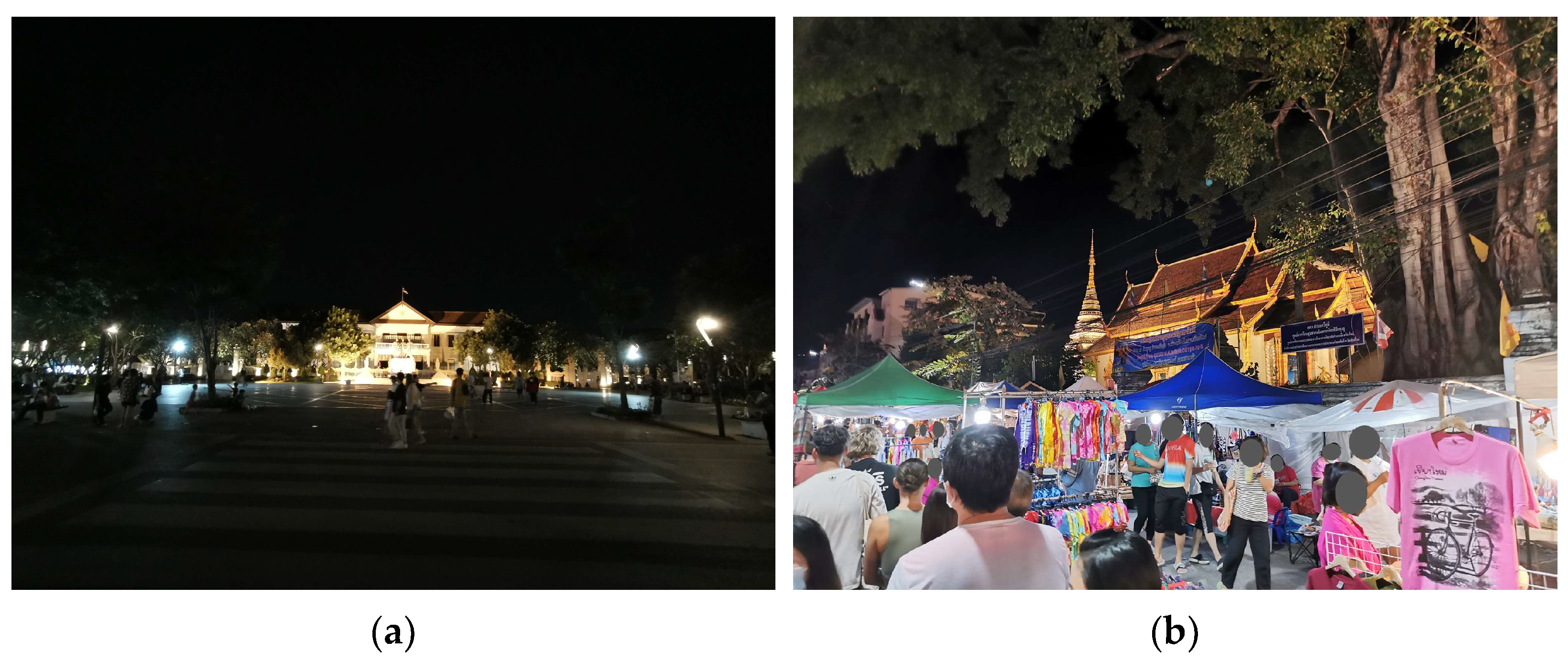
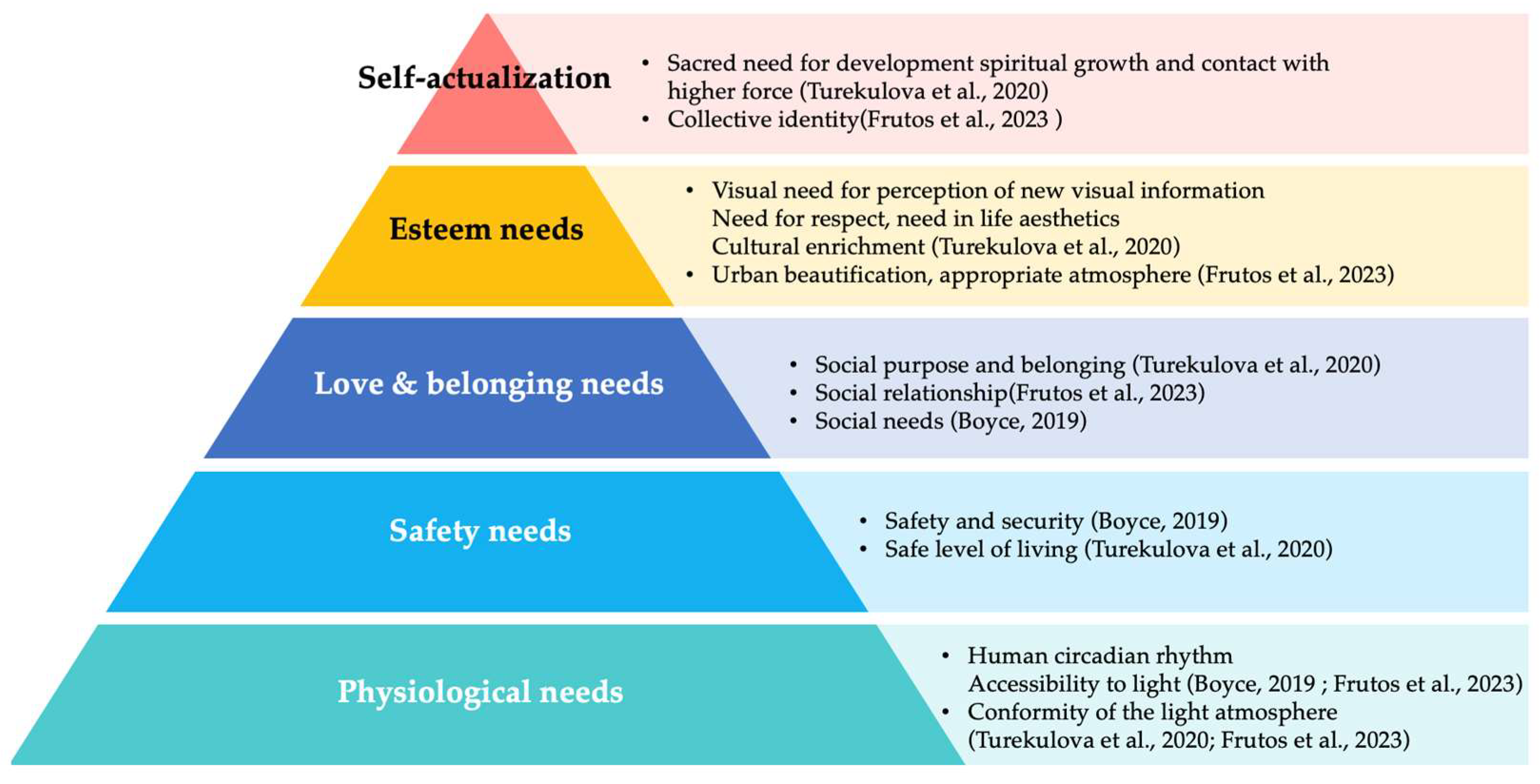
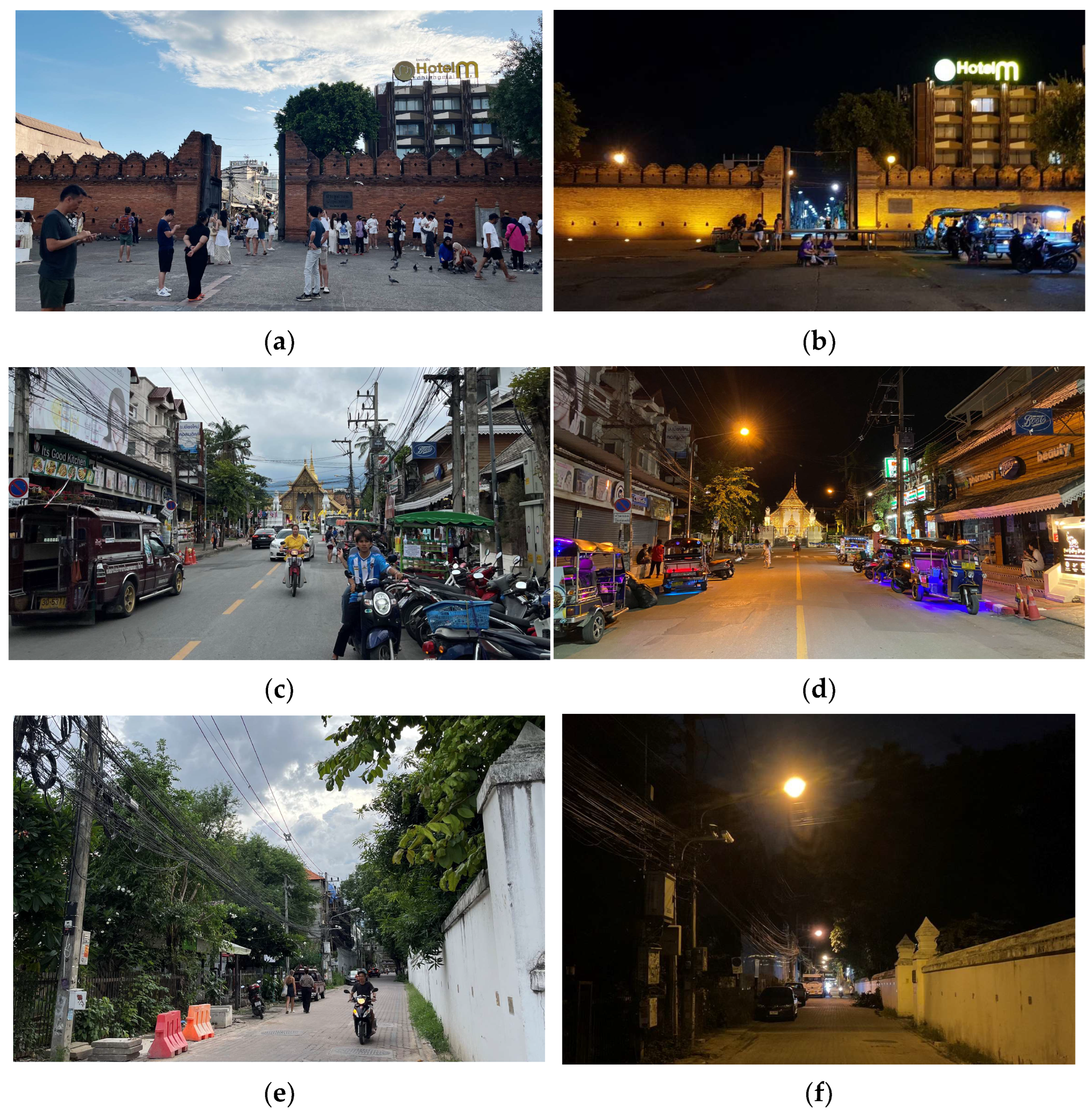
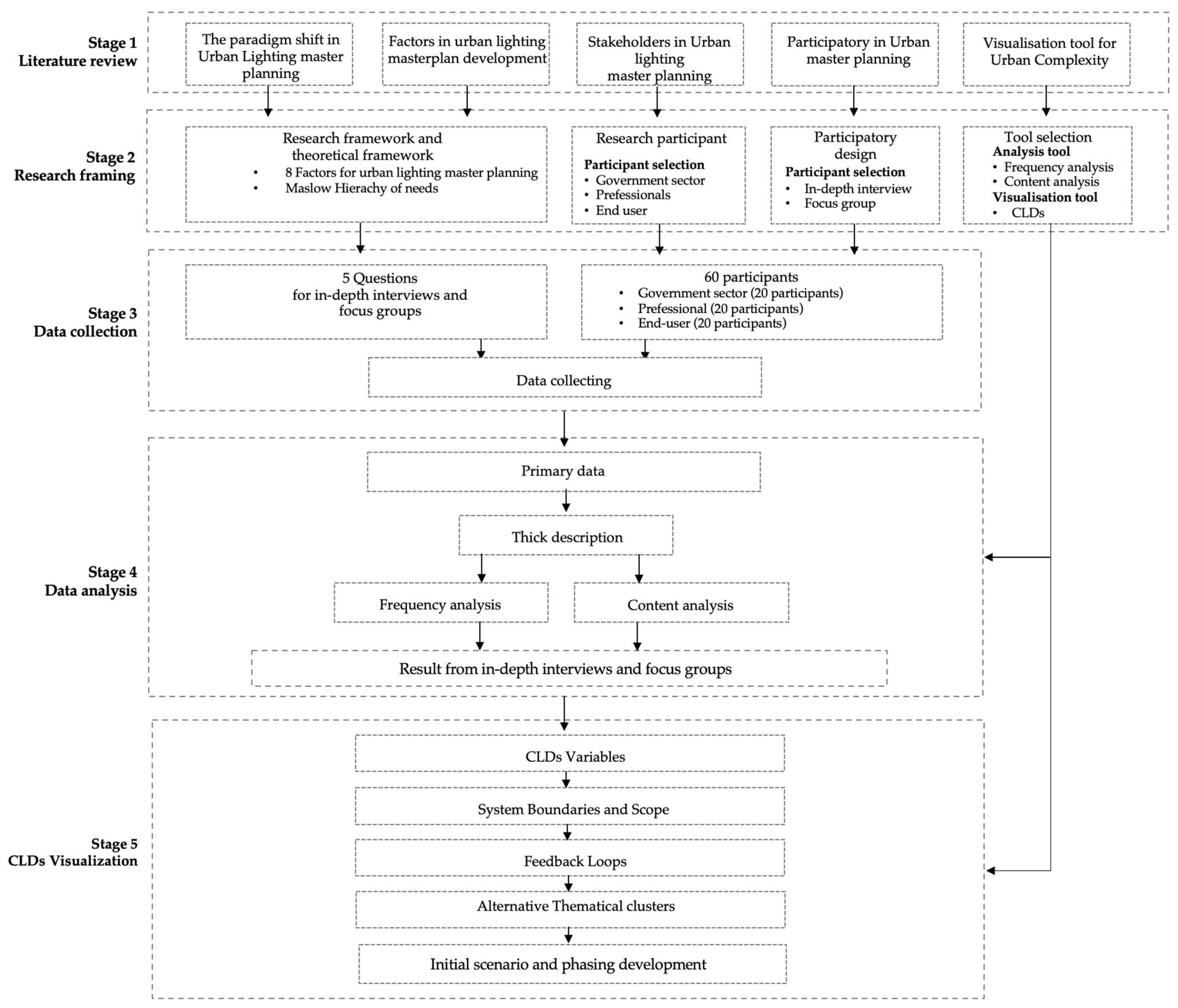
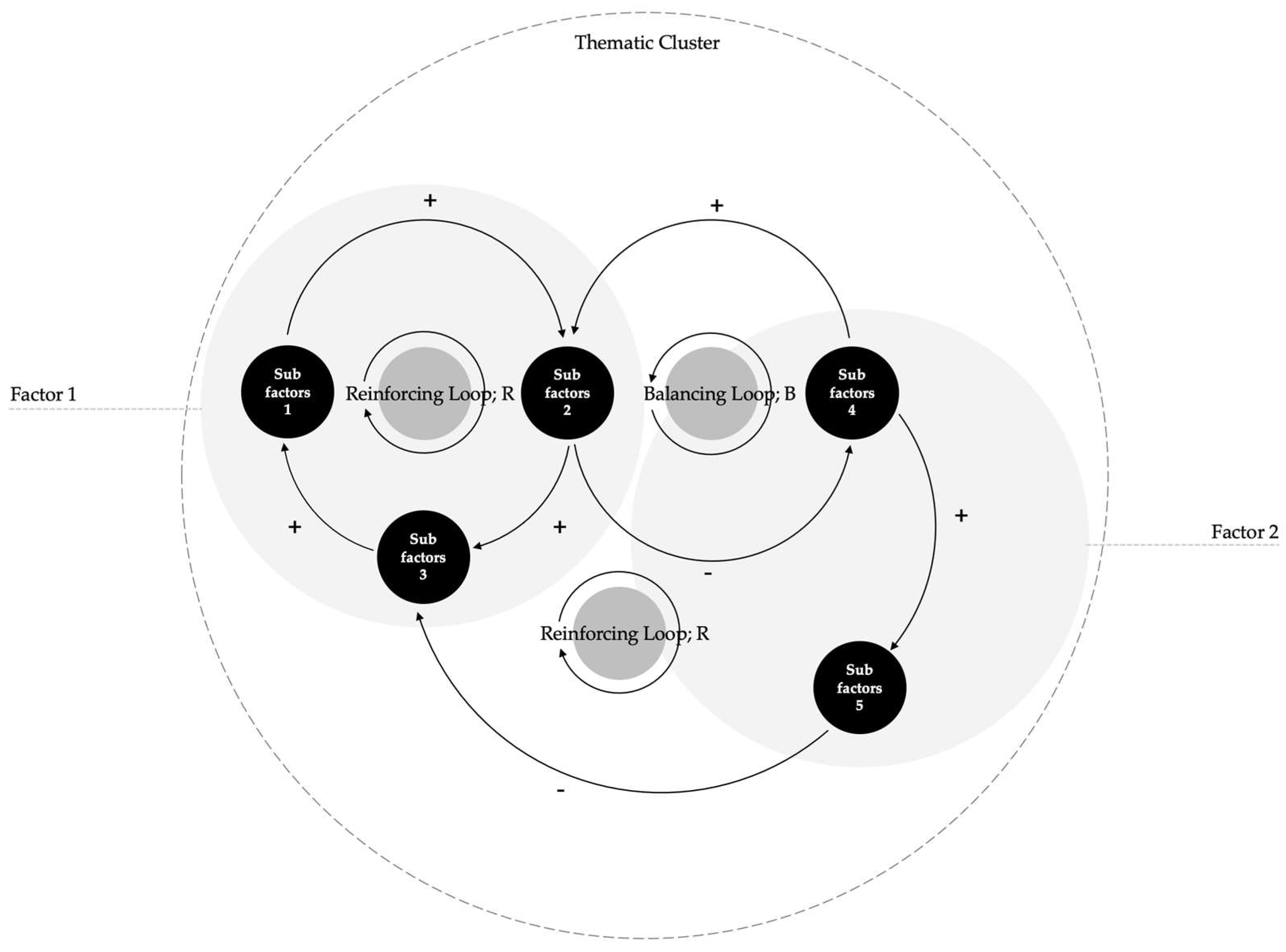
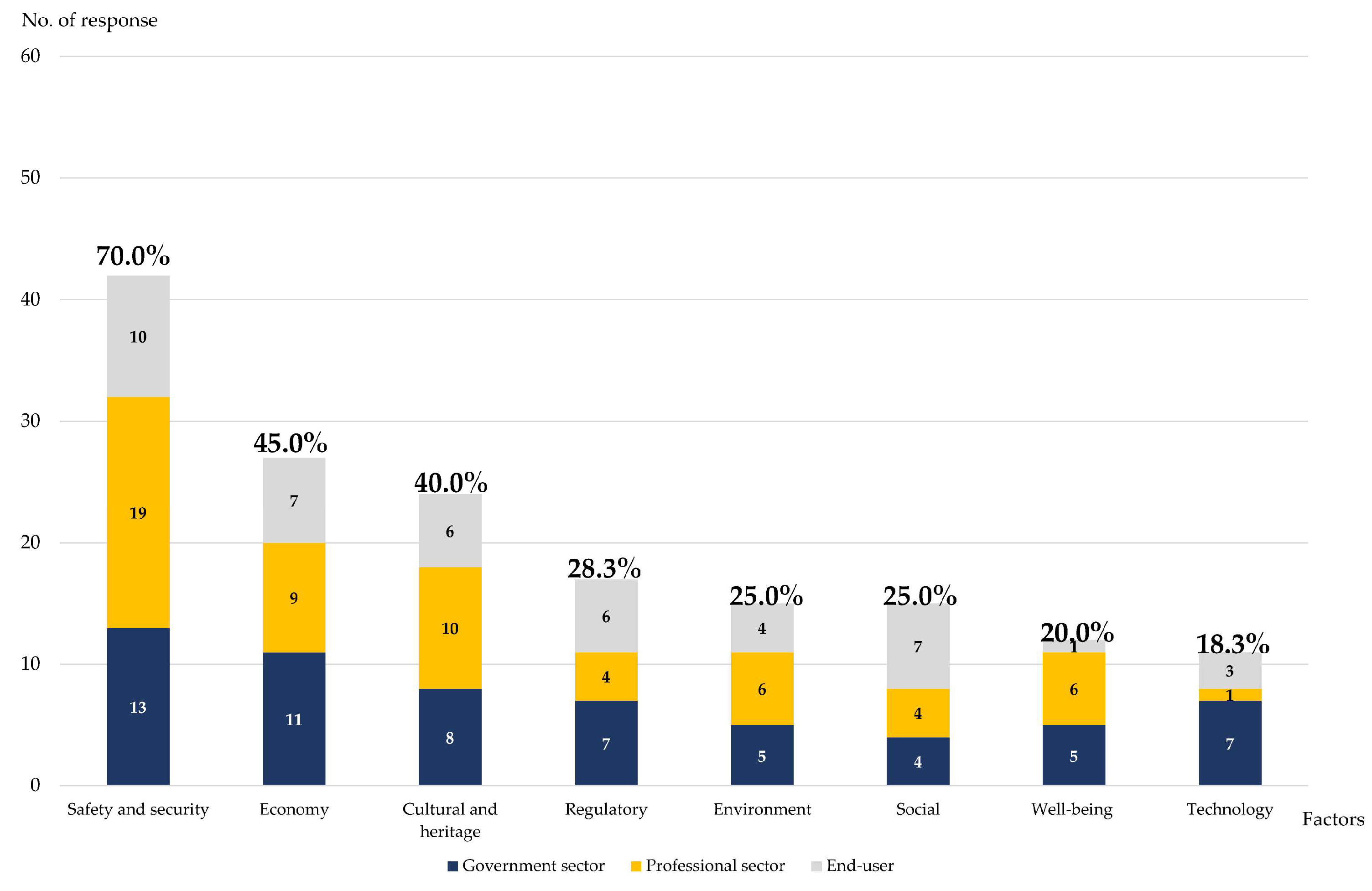
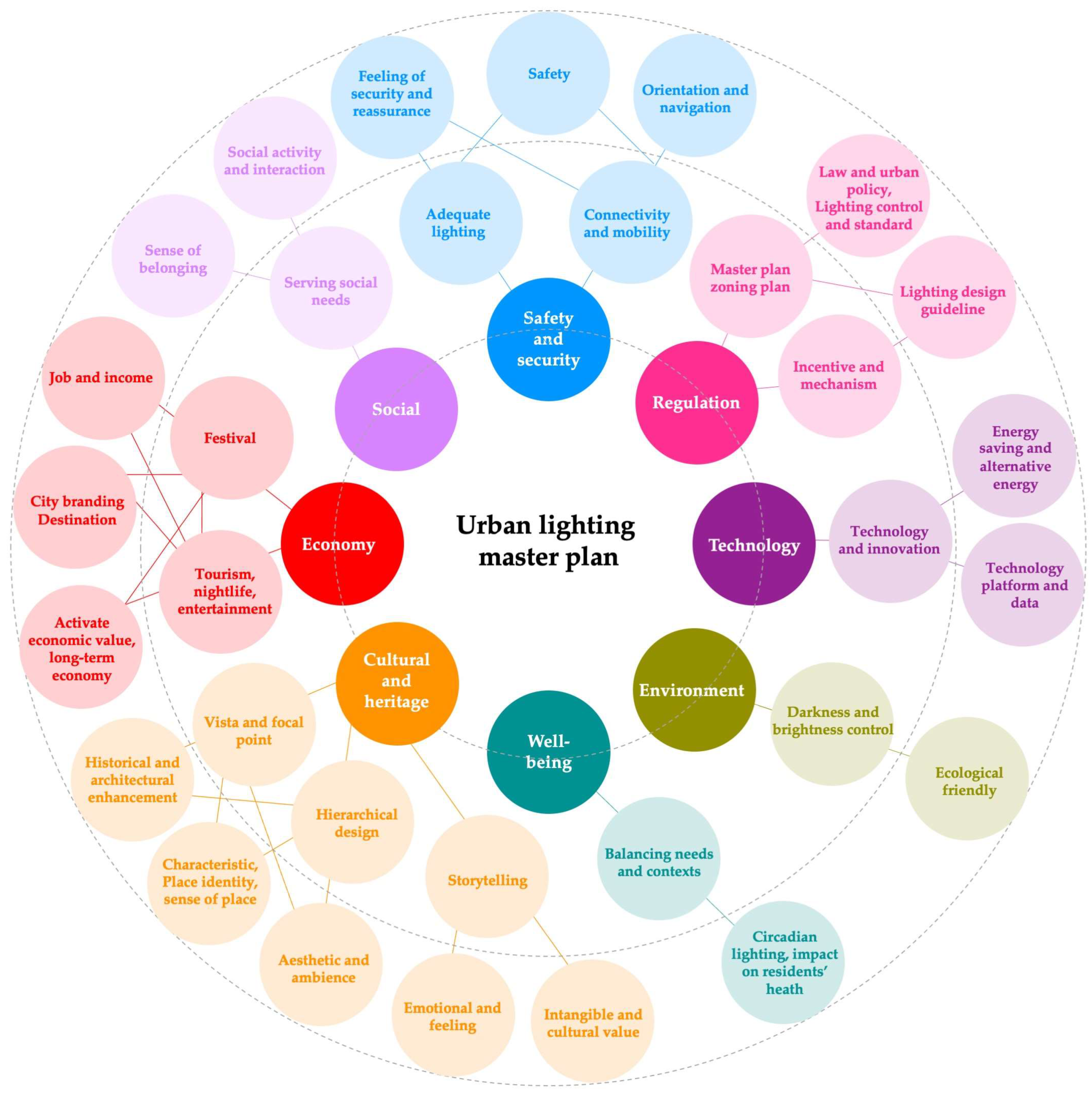
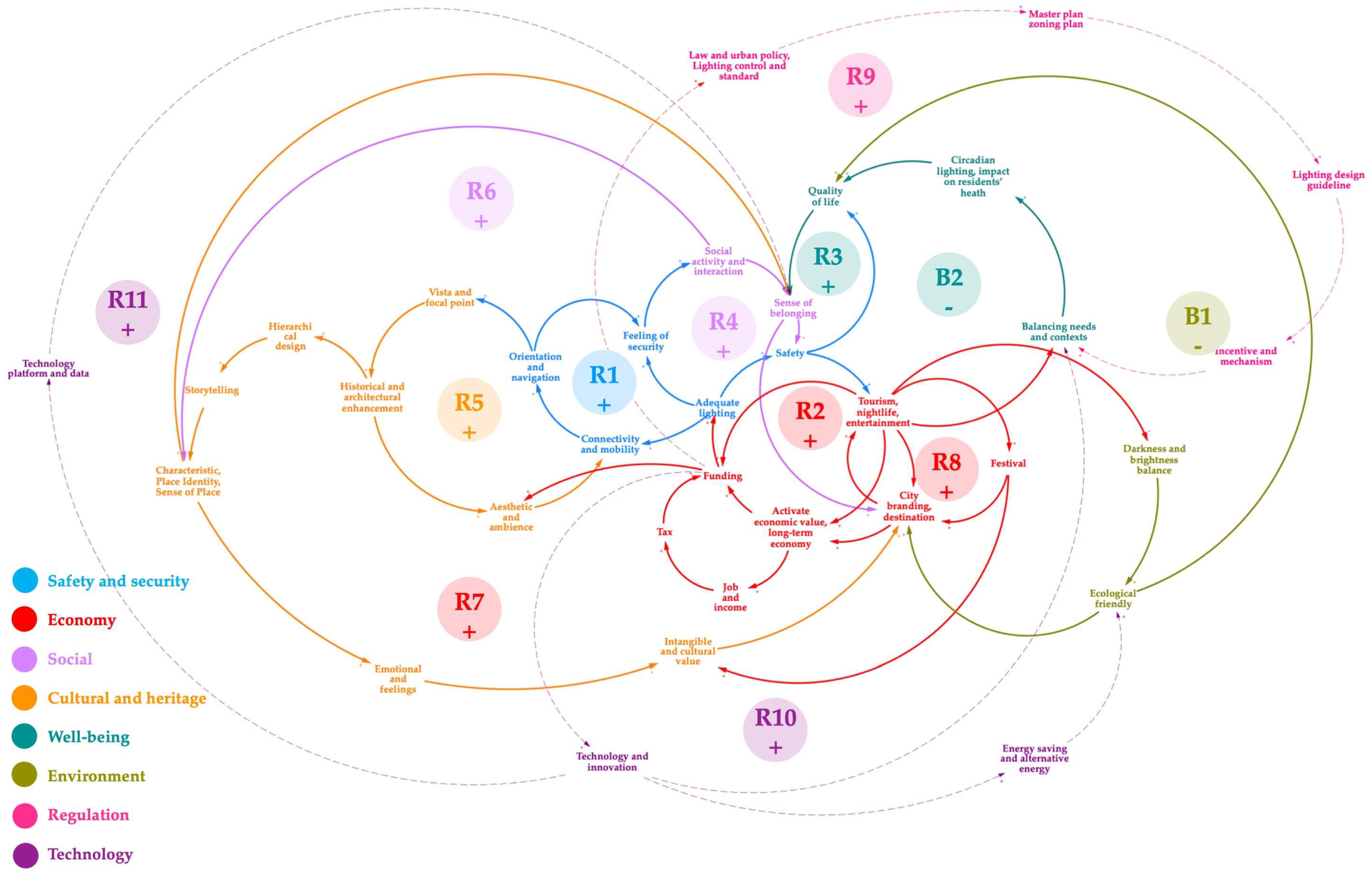

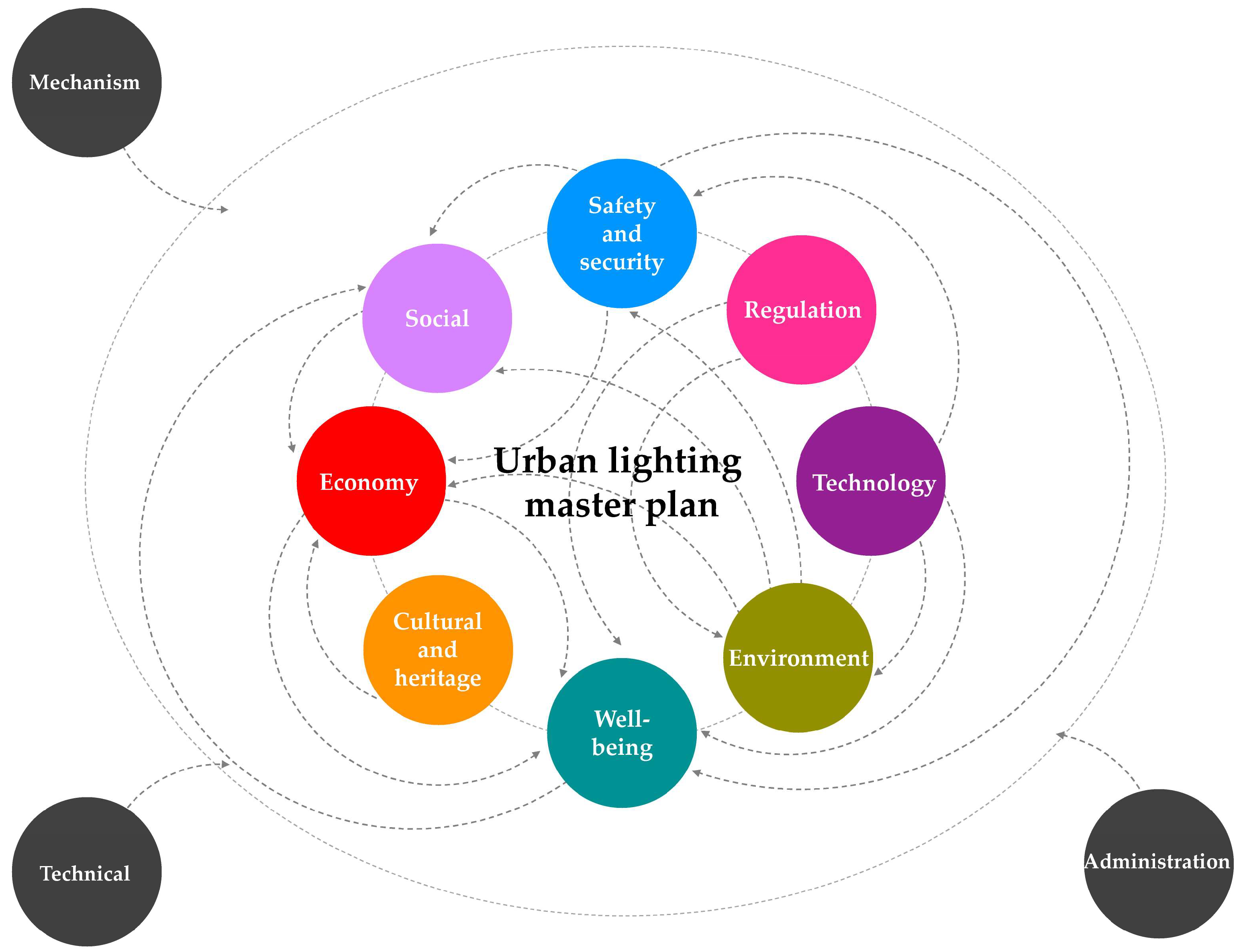
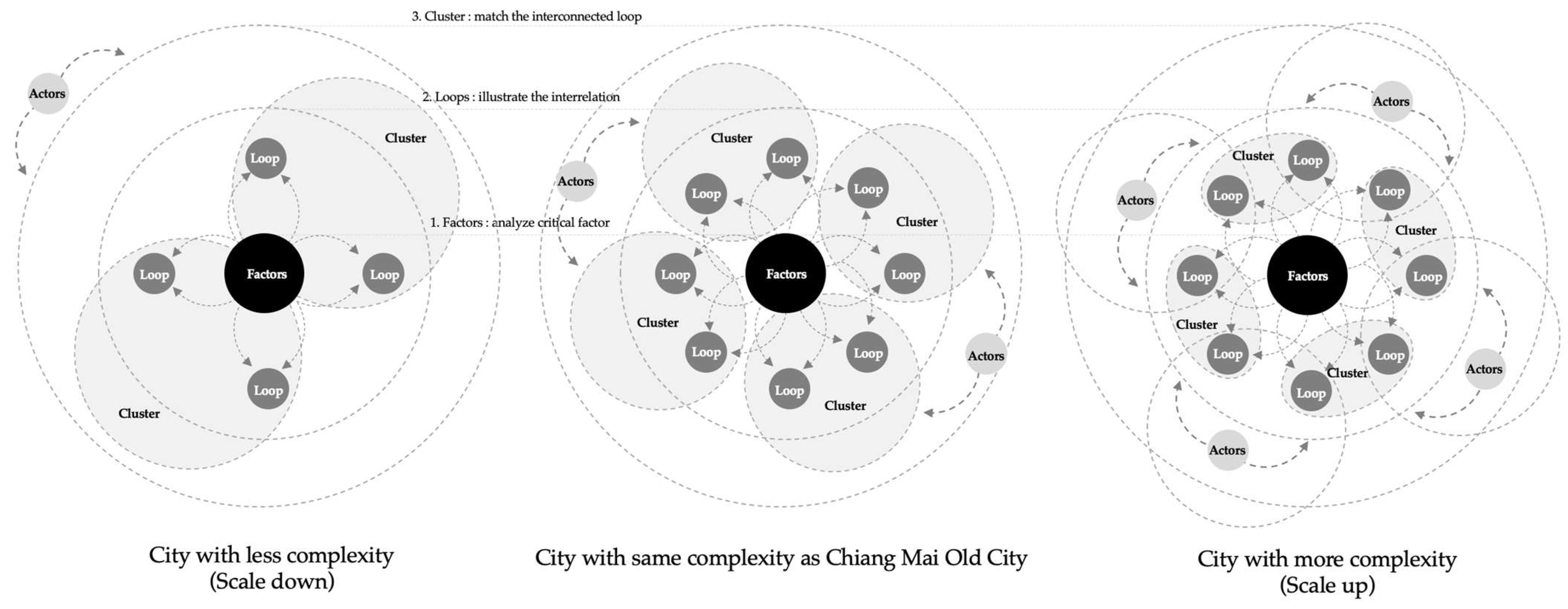
| Factor | Researcher | Urban Element | Lighting Benefits |
|---|---|---|---|
| Safety and security | Johansson et al. [16,62] Böhme [15] Boyce [13] Zielinska-Dabkowska and Bobkowska [17] Portnov [18] Himschoot et al. [19] | Movement (motorized and pedestrian) Footpath Social activity (Public space) Property Signage | Detection of obstacles or surfaces Visual orientation Wayfinding Facial recognition Lighting comfort Reassurance Universal design Brightness and darkness contrast |
| Social | Boyce [13] Entwistle and Slater [20] Zielinska-Dabkowska and Bobkowska [17] Böhme [15] Bille [21] | Public space (Civic space and park) | Perception Space population Usage Experience Atmosphere |
| Economy | Boyce [13] Schulte-Römer et al. [24] Zielinska-Dabkowska [63] Giordano [23] Zielinska-Dabkowska and Bobkowska [17] Böhme [15] Huang and Wang [9] | Public space (Civic space and park) District Streetlighting Private property | Attraction Experience Convivial Entertainment Festival |
| Cultural and heritage | Böhme [15] Edensor and Milington [22] Edensor [64,65,66] Giordano [23] Zielinska-Dabkowska and Xavia [67] Boyce [13] Schulte-Römer et al. [24] Zielinska-Dabkowska and Bobkowska [17] | Historical place Architectural feature Privilege social space Heritage and commercial centers Façade Monument Structures Artefacts | Sense of place Sense of belonging Narrative Storytelling Sensation Carving and texture Place identity Atmosphere Ambience Light phenomena Relative proximity Viewed from a distance |
| Well-being | Veitch [68] Boyce [13] Entwistle and Slater [20] Zielinska-Dabkowska and Bobkowska [69] Zielinska-Dabkowska and Xavia [70] Zielinska-Dabkowska and Bobkowska [17] Pérez Vega et al. [71] | Streetlighting Private property (Façade and advertisement) Historical place Architecture Community | Circadian lighting Lighting pollution Responsible lighting |
| Environment | Pérez Vega et al. [71] Schulte-Römer et al. [24] Hölker et al. [72] Zielinska-Dabkowska and Xavia [70] Zielinska-Dabkowska and Bobkowska [17] | Night sky Landscape Streetlighting Public space (Civic space and park) | Lighting pollution Responsible lighting Light source Lighting level Curfew Sensor and timer |
| Technology | Böhme [15] Ebbensgaard [73] Giordano [23] Entwistle and Slater [20] Zielinska-Dabkowska et al. [74] Zielinska-Dabkowska and Xavia [70] Cellucci et al. [75] Pérez Vega et al. [71] Zielinska-Dabkowska and Bobkowska [17] | Streetlighting Private property (Façade and advertisement) | LED Smart system Public space (Civic space and park) Control system Big data Human-centered lighting Curfew Sensor and timer |
| Regulation | Pérez Vega et al. [71] Zielinska-Dabkowska et al. [74] Zielinska-Dabkowska and Bobkowska [17] Dufner et al. [25] | Movement (motorized and pedestrian) Private property (Façade and advertisement) | Lighting pollution Participatory Organization |
| Literature and Paper | Group | Stakeholder Details | Focus |
|---|---|---|---|
| A guide to urban lighting master planning CIE 234:2019 [57] | Consultation group | National Government Local Government Local Government Departments Non-Governmental Organizations (NGOs) Building Owners and Associations Professional Institutes or Societies Private Companies | Government sector Professional End user |
| Urban lighting master plan–origins, definitions, methodologies and collaborations. Zielinska-Dabkowska [26] | Professional group | Urban planner/designer Architect, Landscape architect, Architectural lighting designer Light artist Engineer Transport planner Consultant/specialist Researcher Cost consultant quality surveyor Manufacturers Contractors User’s representative | Professional End user |
| Rethinking Sustainable Cities at Night: Paradigm Shifts in Urban Design and City Lighting Zielinska-Dabkowska and Bobkowska [17] | Key actors | Client Designer in the built environment Contractor End user | End user |
| Exploring Nightscape LUCI Associate [27] | Public-private cooperation | Public stakeholder (Municipality) Private stakeholder Light producer Citizen | Government sector Professional End user |
| Lighting in the Urban Age Meaningful design for cities, people and place ARUP [25] | Stakeholder groups | Public sector Lighting designer Private sector Citizen | Government sector Professional End user |
| Order | Questions |
|---|---|
| Q1 | How satisfied are you with the current nighttime lighting in Chiang Mai Old City? |
| Q2 | What is your perspective and vision for the role of lighting in the nighttime development of Chiang Mai Old City? |
| Q3 | What are the top three factors that should be prioritized in the design of nighttime lighting for Chiang Mai Old City? (Select 3 out of 8) |
| Q4 | What do you consider to be the potential opportunities in developing nighttime lighting for Chiang Mai Old City? |
| Q5 | Do you have any suggestions for urban lighting development for Chiang Mai Old City? |
| Group | Stakeholders | No. | Total No. |
|---|---|---|---|
| Group 1: Government Sector | Local government | 10 | 20 |
| Central/national government | 10 | ||
| Group 2: Professional Sector | Local architect/urban architect/urban researcher | 8 | 20 |
| Architect/urban architect/urban researcher | 6 | ||
| Lighting designer | 5 | ||
| Lighting manufacturer | 1 | ||
| Group 3: End user | Private owners/business sectors | 5 | 20 |
| Tourism industry | 3 | ||
| Civil society/community | 7 | ||
| Tourists | 6 |
| Elements | Role | Symbol | Description |
|---|---|---|---|
| Nodes | Represent key factors or variables in the system | Variables | These are the critical elements or factors within the system that influence each other. |
| Connections (Arrows) | Indicate the relationships between variables | Positive (+) | A positive relationship: an increase in one variable leads to an increase in the other (or a decrease leads to a decrease). |
| Negative (−) | A negative relationship: an increase in one variable leads to a decrease in the other (or vice versa). | ||
| Loops (Feedback Loops) | Show circular cause-and-effect relationships between variables | Reinforcing (R) | A reinforcing loop amplifies change, creating exponential growth or decline. |
| Balancing (B) | A balancing loop counteracts change, promoting stability or equilibrium. |
| Factor | Sub-Factor | Response Rate (%) | No. of Responses |
|---|---|---|---|
| Safety and security | Adequate lighting, basic infrastructure | 67.5 | 40 (66.7%) |
| Connectivity and mobility | 40.0 | ||
| Safety | 32.5 | ||
| Feeling of security and reassurance | 17.5 | ||
| Orientation and navigation | 10.0 | ||
| Cultural and heritage | Characteristic, place identity, and sense of place | 48.6 | 35 (58.3%) |
| Historical and architectural enhancement | 37.1 | ||
| Aesthetic and ambience | 31.4 | ||
| Hierarchical design | 22.9 | ||
| Storytelling | 20.0 | ||
| Vista and focal point | 14.3 | ||
| Intangible and cultural value | 8.5 | ||
| Emotional and feeling | 2.9 | ||
| Regulation | Law and urban policy, lighting control, lighting standard | 58.1 | 31 (51.7%) |
| Master plan, zoning plan, strategic plan | 54.8 | ||
| Lighting design guideline | 25.8 | ||
| Incentive and mechanism | 22.6 | ||
| Economy | Tourism and nightlife activity and entertainment | 57.9 | 19 (31.7%) |
| Activate economic value, long-term economy | 42.1 | ||
| City branding | 10.5 | ||
| Job and income | 10.5 | ||
| Festival | 5.3 | ||
| Social | Serving social needs | 70.6 | 17 (28.3%) |
| Social activity and interaction | 29.4 | ||
| Technology | Energy saving and alternative energy | 50.0 | 10 (16.7%) |
| Technology and innovation | 40.0 | ||
| Technology platform and data | 10.0 | ||
| Well-being | Circadian lighting, impact on residents’ heath | 75.0 | 8 (13.3%) |
| Balancing needs and contexts | 62.5 | ||
| Environment | Darkness and brightness control | 80.0 | 5 (8.3%) |
| Ecologically friendly | 60.0 |
| Factor | Sub-Factor | Response Rate (%) | No of Responses |
|---|---|---|---|
| Cultural and heritage | Characteristic, place identity, and sense of place | 49.0% | 49 (81.7%) |
| Historical and architectural enhancement | 44.9% | ||
| Aesthetic and ambience | 38.8% | ||
| Intangible and cultural value | 24.5% | ||
| Storytelling | 22.4% | ||
| Hierarchical design | 20.4% | ||
| Emotional and feeling, experience | 16.3% | ||
| Vista and focal point | 16.3% | ||
| Economy | City branding, destination, check-in | 64.1% | 39 (65.0%) |
| Tourism and nightlife activity and entertainment | 48.7% | ||
| Activate economic value | 48.7% | ||
| Festival | 20.5% | ||
| Job and income | 5.1% | ||
| Safety and security | Safety | 76.5% | 34 (56.7%) |
| Connectivity and mobility | 29.4% | ||
| Adequate lighting | 17.6% | ||
| Feeling of security and reassurance | 11.8% | ||
| Orientation and navigation | 8.8% | ||
| Social | Social activity and interaction | 77.3% | 22 (36.7%) |
| Serving social needs | 54.5% | ||
| Sense of belonging | 4.5% | ||
| Well-being | Balancing needs and contexts | 50.0% | 12 (20.0%) |
| Circadian lighting, impact on residents’ heath | 41.7% | ||
| Quality of life | 25.0% | ||
| Environment | Ecologically friendly | 80.0% | 5 (8.3%) |
| Sustainability | 40.0% | ||
| Regulation | Law and urban policy, Lighting control, lighting standard | 50.0% | 2 (3.3%) |
| Lighting design guideline | 50.0% | ||
| Technology | Energy saving and alternative energy | 100.0% | 1 (1.7%) |
| Factor | Sub-Factor | Response Rate (%) | No. of Responses |
|---|---|---|---|
| Cultural and heritage | Cultural capital (Intangible) | 84.1 | 44 (73.3%) |
| Old town morphology (Tangible) | 36.4 | ||
| Lifestyle | 13.6 | ||
| Art and culture | 6.8 | ||
| Economic | One-stop destination | 64.5 | 31 (51.7%) |
| Tourism industry | 48.4 | ||
| Festival | 12.9 | ||
| Nightlife | 9.7 | ||
| Economic value | 6.5 | ||
| People | Professional sector | 63.2 | 19 (31.7%) |
| Community and citizen | 52.6 | ||
| Government sector | 36.8 | ||
| Safety and security | Connectivity and mobility | 66.7 | 3 (5.0%) |
| Safety | 33.3 |
| Factor | Sub-Factor | Response Rate (%) | No. of Responses |
|---|---|---|---|
| Mechanism factor | Social engagement | 59.5 | 37 (61.7%) |
| Key performance indicator | 35.1 | ||
| Awareness and public relation | 27.0 | ||
| Festival/tourism-led | 16.2 | ||
| Pilot project | 13.5 | ||
| Knowledge and expertise | 10.8 | ||
| Technology and innovation | 10.8 | ||
| Incentive | 5.4 | ||
| Technical factor | Master plan, zoning plan, strategic plan | 67.9 | 28 (46.7%) |
| Lighting design guideline | 50.0 | ||
| Law and urban policy, lighting control | 35.7 | ||
| Lighting procedure, standard | 10.7 | ||
| Proposal | 10.7 | ||
| Administration factor | Collaboration | 52.4 | 21 (35.0%) |
| Ownership | 28.6 | ||
| Decision-maker and politician power | 28.6 | ||
| Sponsorship | 14.3 | ||
| Management and maintenance | 9.5 |
| Loops | Category | Type | Description |
|---|---|---|---|
| R1 | Safety and Security, Economy, and Social | Reinforcing | Adequate lighting enhances connectivity and mobility, improving orientation, navigation, and the feeling of security. This increases nighttime activity, activates economy, and in turn, provides funding for urban lighting infrastructure. |
| R2 | Economy | Reinforcing | Lighting transforms the city into a nighttime entertainment destination, boosting tourism, generating income, and increasing long-term economic value. This leads to higher tax revenue and more funding for urban lighting infrastructure. |
| R3 | Well-being and Social | Reinforcing | Improved lighting enhances quality of life, raises awareness of its benefits, promotes social activity and interaction, and fosters a sense of belonging. This, in turn, strengthens feelings of safety, which encourages more nighttime activity and further strengthens community well-being. |
| R4 | Safety and Security, and Social | Reinforcing | Urban lighting increases safety by encouraging social activity in public spaces, promoting a vibrant nighttime social environment. In turn, this enhances feelings of security, which motivates more people to engage in nighttime activities. |
| R5 | Cultural and Heritage | Reinforcing | Lighting highlights historical architecture, creates a visual hierarchy, enhances specific vistas and focal points, aids orientation, and contributes to the city’s nighttime aesthetic appeal. In turn, this strengthens cultural and heritage values, attracting more visitors. |
| R6 | Social, Cultural and Heritage | Reinforcing | Lighting encourages social activities and strengthens social identity, which, in turn, reinforces a sense of place and belonging. This further enhances the cultural and heritage appeal of the area, creating a positive feedback loop that strengthens community identity. |
| R7 | Cultural and Heritage | Reinforcing | Lighting evokes emotions and tells stories, revitalizing the intangible and cultural values of the city. This, in turn, enhances the city’s cultural identity, attracting visitors and creating more opportunities to showcase these values. |
| R8 | Economy | Reinforcing | Well-designed lighting enhances city branding for festivals and nightlife, attracting more tourists. In turn, this generates long-term economic benefits, which provide further funding for urban lighting infrastructure, allowing for continued improvements in lighting design. |
| B1 | Environment | Balancing | Excessive lighting driven by tourism can disrupt the natural balance of brightness and darkness, leading to ecological impacts such as light pollution. In turn, this can create a negative impression for tourists, diminishing their overall experience of the environment. |
| B2 | Social and Well-Being | Balancing | Overexposure to artificial lighting from nightlife activity can disrupt circadian rhythms and negatively impact health. In turn, this leads to negative perceptions of lighting, reduces the social sense of belonging, and, in turn, discourages community engagement in nighttime activities, weakening social cohesion. |
| R9 | Regulation | Reinforcing | Technological advancements provide innovative solutions for lighting control and maintenance, promoting healthier environments. In turn, this contributes to environmental sustainability and well-being, encouraging further technological improvements and investment in lighting systems. |
| R10 | Technology, Well-Being, and Environment | Reinforcing | Technological advancements provide innovative solutions for lighting control and maintenance, promoting healthier environments. In turn, this contributes to environmental sustainability. and well-being, encouraging further technological improvements and investment in lighting systems. |
| R11 | Technology and Social | Reinforcing | Technology platforms enhance social engagement, fostering a sense of belonging within the community. In turn, this increased social interaction helps strengthen ties to the urban space, reinforcing the community’s connection to place and the positive outcomes of better lighting design. |
Disclaimer/Publisher’s Note: The statements, opinions and data contained in all publications are solely those of the individual author(s) and contributor(s) and not of MDPI and/or the editor(s). MDPI and/or the editor(s) disclaim responsibility for any injury to people or property resulting from any ideas, methods, instructions or products referred to in the content. |
© 2024 by the authors. Licensee MDPI, Basel, Switzerland. This article is an open access article distributed under the terms and conditions of the Creative Commons Attribution (CC BY) license (https://creativecommons.org/licenses/by/4.0/).
Share and Cite
Navaraj, P.; Inkarojrit, V. Beyond Illumination: Stakeholder Perspectives on Urban Lighting Master Planning for Chiang Mai Old City, Thailand. Sustainability 2024, 16, 9411. https://doi.org/10.3390/su16219411
Navaraj P, Inkarojrit V. Beyond Illumination: Stakeholder Perspectives on Urban Lighting Master Planning for Chiang Mai Old City, Thailand. Sustainability. 2024; 16(21):9411. https://doi.org/10.3390/su16219411
Chicago/Turabian StyleNavaraj, Preechaya, and Vorapat Inkarojrit. 2024. "Beyond Illumination: Stakeholder Perspectives on Urban Lighting Master Planning for Chiang Mai Old City, Thailand" Sustainability 16, no. 21: 9411. https://doi.org/10.3390/su16219411
APA StyleNavaraj, P., & Inkarojrit, V. (2024). Beyond Illumination: Stakeholder Perspectives on Urban Lighting Master Planning for Chiang Mai Old City, Thailand. Sustainability, 16(21), 9411. https://doi.org/10.3390/su16219411







